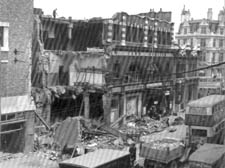| Publications by New Journal Enterprises |
|
| Home | Archive | Competition | Jobs | Tickets | Accommodation | Dating | Contact us |
|
|
This is the story of how one part of Camden survived the horros of aerial bombardment in World War II writes Robin Woolven Wartime St Pancras: A London Borough Defends Itself by Charles Allen Newbery The Camden History Society, £7.50 In November 1945, former St Pancras Councillor Charles Allen Newbery wrote a detailed account of the war in the borough and added to it the reports of the heads of the borough’s Air Raid Precautions (ARP) Services – the Wardens, Light and Heavy Rescue and Ambulance and the range of post-raid welfare services. The paper was never published. Transcribed and annotated by myself and edited by Peter Woodford, Newbery’s memoir has now been published by the Camden History Society . A map of St Pancras shows the location of the many ARP facilities – the five ARP depots, eight First Aid Posts, seven Temporary Ambulance Stations, three First Line Rest Centres and the ARP Mortuary as well as the borough’s two Control and Report Centres and the ARP HQ – the latter site now a supermarket in Camden High Street. The 88-page booklet is illustrated with 26 excellent photographs of local ARP activities recently unearthed in the Camden Archives, most of which have not previously been published. Speaking at the recent launch of Newbery’s paper, I described the solid work of St Pancras officers and elected members as well as the excellent response of council employees and members of the public in volunteering and training for, as well as performing under fire in, the range of ARP Services. The author was elected to St Pancras Council in October 1937 and quickly elected Chairman of the ARP Committee, He soon became Chief Warden (like greengrocer Hodges of Dads Army) then, when the ARP Officer was recalled to the army, Newbery took over as ARPO. A year later he moved on to become the Salvage Officer. The other two officers deserving special mention are the ARPO, Major Noel MacRoberts DSO MC and Mr Cyril Bainbridge, the Borough Engineer and Surveyor who drew up the St Pancras ARP Scheme and then served as ARP Controller for the duration of the war. Down the council hierarchy, many of the ARP volunteer Services were manned by council workmen such as the Decontamination and Repair Services whose squads were formed on a voluntary basis from the men of the Highways Department, and training was carried out after normal working hours. Newbery’s Paper reminds us of the tribulations of the people by recording: “Over 13,000 homeless people were admitted to the rest centres in St Pancras during the war. The rest centre organisation carried out great work in helping the bombed out over the first few days or even weeks, imparting information regarding all types of assistance available from other services, eg: Assistance Board, Billeting, Claims, or Furniture removal, and making enquiries regarding casualties, and generally assisting in sorting out problems. “Homeless people were transferred to hostels. In St Pancras the Rehousing Department operated in 14 hostels, taking over hotels, boarding houses, a part of the Foundling Hospital headquarters, three houses in Brunswick Square and the Royal Veterinary College. Rehousing all these people was very difficult, as bombing did not cease until 1945. “From the beginning of enemy action to the end of the war billeting warrants were issued for 8,536 people, and 814 families totalling 2,780 people were rehoused in requisitioned property. During the two years from December 1940 to the end of 1942 most vacancies on the council’s estates were made available to the Rehousing Department for bombed-out families, and 310 families totalling 940 people were rehoused in this way.” Quoting the work of one service unfortunately neglects the work of others – such as the jobs done by the WVS (originally the Women’s Voluntary Service for Air Raid Precautions). Their welfare work was not restricted to serving tea and meals to the homeless but extended to setting up Information Points at bomb incidents – informing the homeless where they could get advances of cash, replacement ration books and identity cards, information on other survivors and on casualties. The WVS ladies also coped with the influx of foreign refugees in the borough, escorted internees in locked trains to Liverpool en route to their camps in the Isle of Man, distributed clothing, organising play centres and evacuated the elderly. Fortunately Newbery’s Paper provides lots of similar information on the other St Pancras Services. |
|
|
All content © New Journal Enterprises, 2006 designed by The Innovatory |

